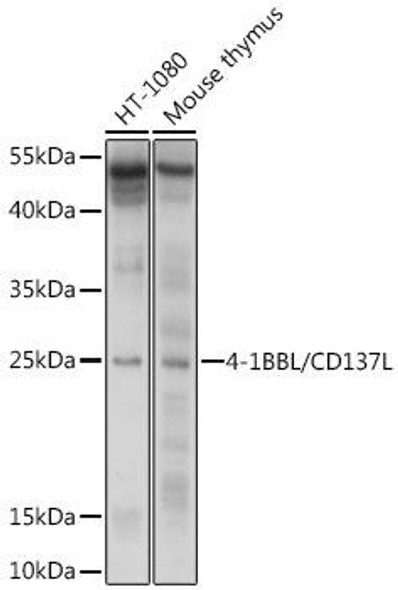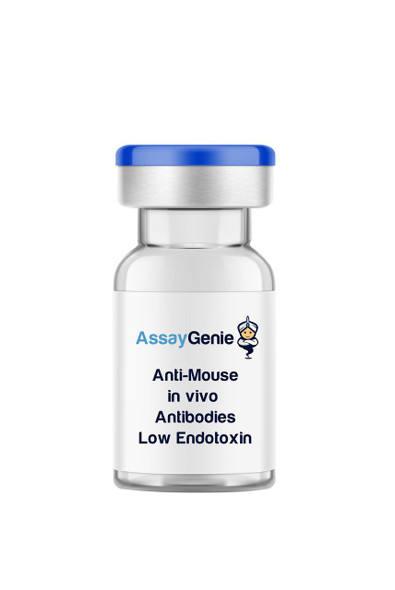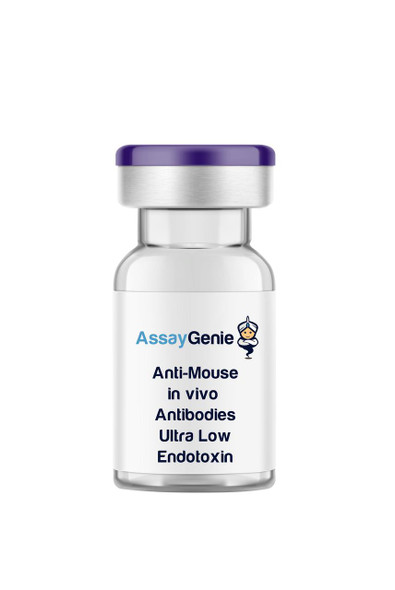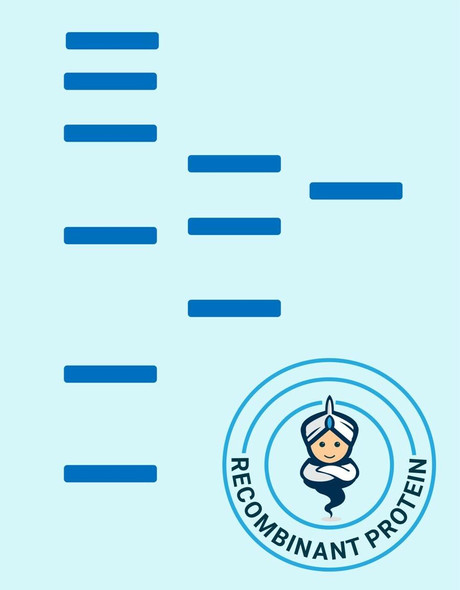Description
| Product Name: | 4-1BBL/CD137L Rabbit mAb |
| Product Code: | CAB3386 |
| Size: | 20uL, 50uL, 100uL |
| Synonyms: | 4-1BB-L, CD137L, TNLG5A |
| Applications: | WB |
| Reactivity: | Human, Mouse, Rat |
| Host Species: | Rabbit |
| Immunogen: | A synthesized peptide derived from human 4-1BBL/CD137L |
| Applications: | WB |
| Recommended Dilutions: | WB 1:500 - 1:2000 |
| Reactivity: | Human, Mouse, Rat |
| Positive Samples: | HeLa, Raji, SH-SY5Y, Mouse lung, Mouse brain, Rat lung |
| Immunogen: | A synthesized peptide derived from human 4-1BBL/CD137L |
| Purification Method: | Affinity purification |
| Storage: | Store at -20°C. Avoid freeze / thaw cycles. Buffer: PBS with 0.02% sodium azide, 0.05% BSA, 50% glycerol, pH7.3. |
| Isotype: | IgG |
| Sequence: | Email for sequence |
| Gene ID: | 8744 |
| Uniprot: | P41273 |
| Cellular Location: | Membrane, Single-pass type II membrane protein |
| Calculated MW: | 25-32kDa |
| Observed MW: | 27kDa |
| UniProt Protein Function: | TNFL9: Cytokine that binds to TNFRSF9. Induces the proliferation of activated peripheral blood T-cells. May have a role in activation-induced cell death (AICD). May play a role in cognate interactions between T-cells and B-cells/macrophages. Belongs to the tumor necrosis factor family. |
| UniProt Protein Details: | Protein type:Apoptosis; Cell cycle regulation; Cytokine; Membrane protein, integral Chromosomal Location of Human Ortholog: 19p13.3 Cellular Component: plasma membrane Molecular Function:receptor binding; tumor necrosis factor receptor superfamily binding Biological Process: apoptosis; cell proliferation; cell-cell signaling; positive regulation of activated T cell proliferation; positive regulation of cytotoxic T cell differentiation; signal transduction; tumor necrosis factor-mediated signaling pathway |
| NCBI Summary: | The protein encoded by this gene is a cytokine that belongs to the tumor necrosis factor (TNF) ligand family. This transmembrane cytokine is a bidirectional signal transducer that acts as a ligand for TNFRSF9/4-1BB, which is a costimulatory receptor molecule in T lymphocytes. This cytokine and its receptor are involved in the antigen presentation process and in the generation of cytotoxic T cells. The receptor TNFRSF9/4-1BB is absent from resting T lymphocytes but rapidly expressed upon antigenic stimulation. The ligand encoded by this gene, TNFSF9/4-1BBL, has been shown to reactivate anergic T lymphocytes in addition to promoting T lymphocyte proliferation. This cytokine has also been shown to be required for the optimal CD8 responses in CD8 T cells. This cytokine is expressed in carcinoma cell lines, and is thought to be involved in T cell-tumor cell interaction.[provided by RefSeq, Oct 2008] |
| UniProt Code: | P41273 |
| NCBI GenInfo Identifier: | 728739 |
| NCBI Gene ID: | 8744 |
| NCBI Accession: | P41273.1 |
| UniProt Secondary Accession: | P41273,Q2M3S2, |
| UniProt Related Accession: | P41273 |
| Molecular Weight: | 27kDa |
| NCBI Full Name: | Tumor necrosis factor ligand superfamily member 9 |
| NCBI Synonym Full Names: | TNF superfamily member 9 |
| NCBI Official Symbol: | TNFSF9 |
| NCBI Official Synonym Symbols: | CD137L; TNLG5A; 4-1BB-L |
| NCBI Protein Information: | tumor necrosis factor ligand superfamily member 9 |
| UniProt Protein Name: | Tumor necrosis factor ligand superfamily member 9 |
| UniProt Synonym Protein Names: | 4-1BB ligand; 4-1BBL |
| Protein Family: | Tumor necrosis factor ligand superfamily |
| UniProt Gene Name: | TNFSF9 |






